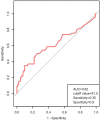Clinical Profile and Risk Factors for Cardiac Death in Pediatric Patients With Primary Dilated Cardiomyopathy at a Tertiary Medical Center in China
- PMID: 35573962
- PMCID: PMC9096786
- DOI: 10.3389/fped.2022.833434
Clinical Profile and Risk Factors for Cardiac Death in Pediatric Patients With Primary Dilated Cardiomyopathy at a Tertiary Medical Center in China
Abstract
Aim: We sought to identify the clinical characteristics and risk factors for cardiac mortality in pediatric patients with primary dilated cardiomyopathy (DCM) in China.
Methods: A total of 138 pediatric patients who were consecutively diagnosed with primary DCM from January 2011 to December 2020 were included. We assessed patients' clinical symptoms and performed laboratory examinations, electrocardiography, and echocardiography.
Results: Of these patients, 79 (57%) had severe systolic dysfunction (left ventricular ejection fraction of < 30%), 79 (57.2%) developed DCM before 12 months of age, 62 (45%) were male, 121 (87.7%) presented with advanced heart failure (cardiac functional class III/IV), and 54 (39.1%) presented with arrhythmia. At a median follow-up of 12 months, the overall cardiac mortality rate was 33%, and 40 of 46 deaths occurred within 6 months following DCM diagnosis. A multivariate Cox regression analysis identified several independent cardiac death predictors, including an age of 12 months to 5 years [hazard ratio (HR) 2.799; 95% confidence interval (CI) 1.160-6.758; P = 0.022] or 10-15 years (HR 3.617; 95% CI 1.336-9.788; P = 0.011) at diagnosis, an elevated serum alanine aminotransferase (ALT) concentration (≥ 51.5 U/L) (HR 2.219; 95% CI 1.06-4.574; P = 0.031), and use of mechanical ventilation (HR 4.223; 95% CI 1.763-10.114; P = 0.001).
Conclusion: The mortality rate of primary DCM without transplantation is high. Age, an elevated serum ALT concentration, and the need for mechanical ventilation predict mortality in patients with primary DCM, providing new insights into DCM risk stratification.
Keywords: dilated cardiomyopathy; heart failure; mortality; pediatric patient; risk factor.
Copyright © 2022 Wang, Han, Fan, Yi, Lv, Wang, Yang, Jiang, Zhao, Zhang and Yuan.
Conflict of interest statement
The authors declare that the research was conducted in the absence of any commercial or financial relationships that could be construed as a potential conflict of interest.
Figures



References
-
- Alvarez JA, Orav EJ, Wilkinson JD, Fleming LE, Lee DJ, Sleeper LA, et al. Competing risks for death and cardiac transplantation in children with dilated cardiomyopathy: results from the pediatric cardiomyopathy registry. Circulation. (2011) 124:814–23. 10.1161/CIRCULATIONAHA.110.973826 - DOI - PMC - PubMed
-
- Pinto YM, Elliott PM, Arbustini E, Adler Y, Anastasakis A, Bohm M, et al. Proposal for a revised definition of dilated cardiomyopathy, hypokinetic non-dilated cardiomyopathy, and its implications for clinical practice: a position statement of the ESC working group on myocardial and pericardial diseases. Eur Heart J. (2016) 37:1850–8. 10.1093/eurheartj/ehv727 - DOI - PubMed
-
- Richardson P, McKenna W, Bristow M, Maisch B, Mautner B, O’Connell J, et al. Report of the 1995 World Health Organization/International society and federation of cardiology task force on the definition and classification of cardiomyopathies. Circulation. (1996) 93:841–2. 10.1161/01.cir.93.5.841 - DOI - PubMed
LinkOut - more resources
Full Text Sources

